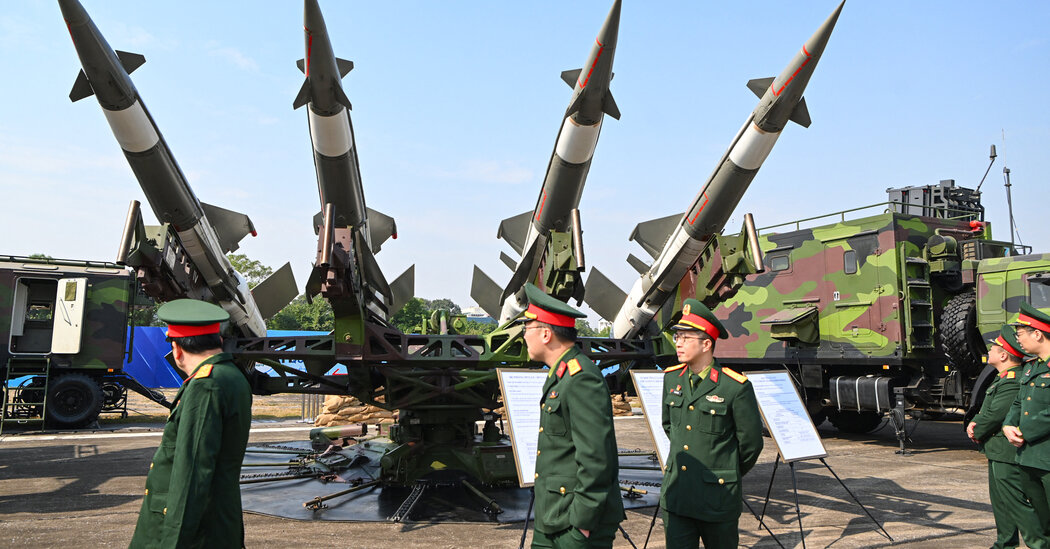Vietnam and Russia have reinvigorated their military and political relationship.
A New York Times investigation — relying on documents from a Russian defense supplier and interviews with officials from Vietnam, the United States and other countries — has identified a string of Russian military purchases by Vietnam, covert payment systems and a major shift in tone as Hanoi grows distant from Washington and closer to Moscow.
Together with high-level meetings and public records, the transactions highlight not just Vietnam’s shifting geopolitics after a period of warming relations with the U.S. under President Biden, but also Russia’s brazen attempt to prove — in China’s neighborhood — that it’s still a major power.
Here are three takeaways from our reporting.
Vietnam is secretly buying arms from Russia.
In Vietnamese military circles online this summer, rumors of Vietnam signing significant new deals with Russia for air and sea defenses, in likely defiance of international sanctions, began to surface. A snippet of a spreadsheet was shared with me by a source. It showed Vietnam — customer 704 — buying an electronic warfare system for the Su-35, a sophisticated fighter jet by Sukhoi.
A senior Vietnamese military officer confirmed that the country was considering a variety of aircraft. Its fighter jets and helicopters, including some built in the 1980s, desperately needed replacing.
A congressional official confirmed that Congress was briefed earlier this year on a classified assessment of Vietnam’s military acquisitions and upgrades of naval and air defenses — a sign of alarm following proposals for sales of American military equipment that never happened.
Then this month, a pro-Ukrainian hacker group released around 1,000 documents from Rostec, a major Russian military exporter. Buried in hundreds of records with file names like ____ _____ ____ 2.pdf were references to Vietnam (customer 704).
The full spreadsheet found in the files confirmed orders from Iran, Algeria — and Vietnam’s order for nine of the Su-35’s electronic warfare systems. These systems and ground-based versions (of which Vietnam bought several sets and components for nearly $190 million) can jam and redirect missiles.
Vietnam has not announced those purchases nor any order for Russian jets. But military analysts who reviewed the records say they point to what is likely Vietnam’s largest defense order in years, at a time when money flowing to Russia — a form of support for its war against Ukraine — has become more of a focus for the United States and Europe.
One of several Vietnamese officials who confirmed that large purchases from Russia are being made said the deal was worth $8 billion and included 40 new fighter jets.
Third-party intermediaries were used to hide payments.
The records from Rostec, a major military exporter, included complaints from employees about delays in receiving payments because they had to be funneled through other companies in order to evade international sanctions against Russia.
In 2023, a document from Vietnam’s Ministry of Finance laid out a plan for routing payments through a Russian-Vietnamese oil and gas joint venture. The Rostec documents pointed to additional military-technical joint ventures. One of the records noted that a company in Hanoi had been added to the sanctions list of the United States, which was confirmed with a U.S. Treasury Department database. Security guards prevented a visit to the company offices, in a working-class area of Hanoi.
Trump is alienating Vietnamese officials.
U.S.-Vietnam relations reached a new high in 2023, during the Biden administration, with their elevation to a comprehensive strategic partnership in and a presidential visit.
But Mr. Trump has reversed the trend of steady postwar reconciliation that began in the 1990s with a series of policies that Vietnamese officials have found frustrating. It started with cuts to foreign aid. That was followed in April by a proposed tariff of 46 percent for Vietnam.
Even after that was cut to 20 percent, Vietnamese officials continued to complain that American negotiators would promise one thing then do another, or present vague plans or demands then hit Vietnam with a surprise. That happened again with the U.S. tariffs on furniture, which is a growing industry that the Vietnamese government had planned to prioritize over lower-skilled sectors like apparel.
Vietnam is not blaming Mr. Trump for its purchases of Russian military equipment. But it is saying that it needs to move forward on its own, as relations between China and the U.S. deteriorate. For now, as it did in the past, Hanoi trusts Moscow far more than Washington.
“The U.S. must accept that Vietnam’s defense transition to a more diversified source of supply is a long-term process,” said one Vietnamese military official, who spoke on condition of anonymity to discuss sensitive diplomatic matters. “It cannot be done overnight. Instead of pressuring Vietnam to stop purchasing weapons from Russia, the U.S. should boost cooperation in non-military sectors.”
Damien Cave leads The Times’s new bureau in Ho Chi Minh City, Vietnam, covering shifts in power across Asia and the wider world.
The post 3 Takeaways From Vietnam’s Drift Toward Russia and Away From America appeared first on New York Times.




